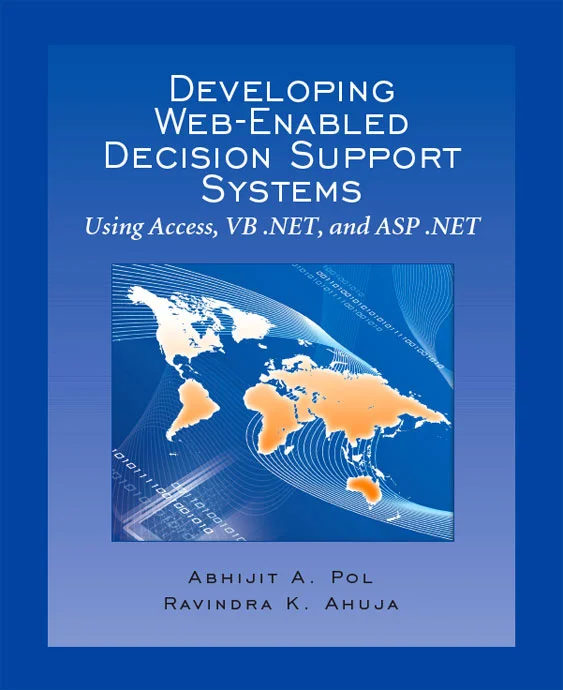Developing Web-Enabled Decision Support Systems
Developing Web-Enabled Decision Support Systems
by Abhijit A. Pol and Ravindra K. Ahuja
Decision support systems combine models, data, and information technology for effective decision-making and are becoming increasingly popular in business and industry. Developing Web-Enabled Decision Support Systems is a comprehensive book that describes how to build data-driven, Web-enabled decision support systems using a Microsoft Access database, VB .NET, and an ASP .NET framework and illustrates it using several case studies arising in Management, Engineering, and Operations Research.
Educational Philosophy
Information systems based on decision models are called Decision Support Systems (DSS). A DSS uses the data residing in databases, models it, processes or analyzes it using problem-specific methodologies, and assists the user in the decision-making process through a graphical user interface. Industrial Engineering and Operations Research (IE/OR) and business school graduates are frequently being employed in positions that require developing DSS. We believe that decision support systems will gain widespread popularity in the future, and knowing how to develop such systems will make our students highly desirable in the workplace.
IE/OR departments and business schools teach their students decision models-based courses that impart spreadsheet modeling, optimization, and simulation skills. Most of these departments require their students to take computer-programming courses, often in C++, Java, or Visual Basic (VB). Several departments require their students to take a database course as well. Thus, students acquire background in modeling, optimization, simulation, databases, and programming, but there are no courses that teach students how to integrate the technologies learned in these different courses to build complete decision support systems. Students are given many components, but they cannot assemble them into a complete package suitable for use by a customer. Decision support systems combine these technologies, and teaching how to build such systems is ideally suited to be an integral part of the IE/OR and business school curriculum. This book addresses this important need and illustrates how to build complete systems using various techniques learned in different courses. We believe these skills will make our students highly desirable and sought after in today’s information technology dominated workplace.
Distinguishing Characteristics
- A unified approach that describes all technologies necessary to build a complete web-based decision support system. The book covers the material found in several books in one book and makes it highly accessible for students with little previous background.
- This is the first book that covers integration of operations research methodologies with information technology techniques related to web development.
- All important topics are explained using easy-to-follow and interesting hands-on tutorials. Numerous hands-on exercises further supplement the learning experience.
- This book can be used as a textbook for teaching courses at the undergraduate as well as graduate levels in industrial engineering, operations research, and business departments. The book can also be used as a self-study guide by practitioners wanting to learn more about operations research and/or information technology.
- The book can also be used to supplement existing courses. The book material is organized in a modular fashion so that instructors can pick and choose certain modules to supplement other courses they teach.
The book is composed of five parts:
- Part 1: Principles of Good Database Design
- Part 2: Database Development with Microsoft Access
- Part 3: Windows Application Development with VB .NET
- Part 4: Web Application Development with ASP .NET
- Part 5: Case Studies
No prior knowledge or background in information systems, databases, or database management systems required. Each topic covered is illustrated through examples and hands-on tutorials. Each chapter contains several hands-on exercises for additional practice. This book is ideally suited as a textbook for teaching undergraduate- and graduate-level courses in any branch of science, engineering, and management but can also be used as a supplementary reference book or a self-study manual.

